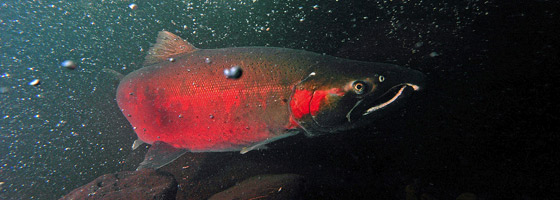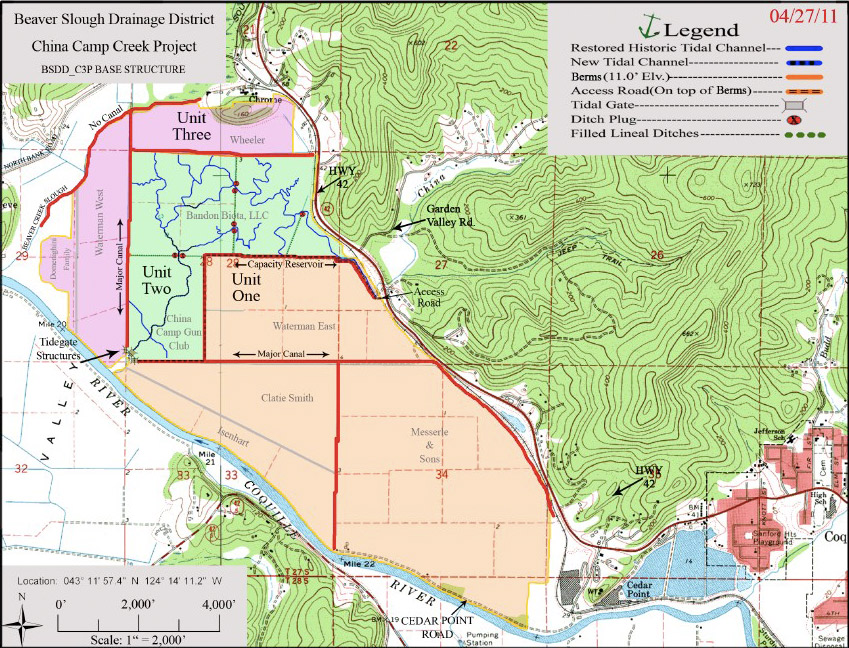Land-use plan could be win for conservation and commerce

When completed, an innovative reclamation project in the Coquille River Basin in Oregon will have dramatic effects on the health of critical salmon habitat and the productivity of adjacent grazing land. Though still in the design phases, the China Camp Creek project, as it is called, has amassed a broad base of support from local stakeholders.
The project came about when the Nature Conservancy approached the local drainage district with the possibility of a land trade, said Steve Denney, Nature Conservancy’s South Coast Conservation Director. While the initial land swap proposal was panned by local landowners, the current plan grew organically out of the ashes, said Fred Messerle, chairman of the Beaver Slough Drainage District.
The project deals firstly with a body of water known as Winter Lake, a product of annual flooding from October to May. The area is an example of competing land uses, as well as the particular tradeoffs unique to the Pacific Northwest. With much available land covered in valuable timber forest, agriculture and grazing was forced to make do with marginal coastal land. These areas were prone to flooding by brackish estuarine water, making the land unfit for use much of the time. As far back as the late 1800s, dikes were built and drainage facilitated by tide gates – hinged metal and wood structures controlled by differential water pressure that allowed up-river water to flow out, but prevented incoming tides from flooding the land. Unfortunately, these lands are also the habitat that spawning and young salmon depend on.
Juvenile Coho salmon spend the first year of their lives in fresh water, and use the flooded channels as a respite from fast-moving river water. Winter Lake is just such an environment.
“The number one limiting factor in that was what we call the loss of ‘slow water off channel over winter habitat,’” Denny explained.
Current salmon runs are mere fractions of historic highs, and experts, conservationists, governments and businesses are paying attention. The Coquille Basin was historically one of Oregon’s prime salmon areas, with around 450,000 Coho salmon swimming back through to spawn. Over the last ten years, those runs have crashed, with salmon numbering 8,000 – 30,000 fish.

Per the plans of the China Camp Creek project, the flooded area of Winter Lake will be divided into three tracts, each with its own tide gate. Two of the tracts will be highly regulated and drained to allow for grazing. Another benefit of the new gate design is that period intentional backflooding of the land can occur, submerging it in nutrient-rich water and thereby enhancing its productivity. The gate of the third tract will be set nearly completely open, allowing the land to be almost completely under tidal influence and providing the over-winter habitat for salmon. Also in the works is a plan to connect this more tidally influenced tract back to China Camp Creek, and restore that waterway’s natural winding path. Historic vegetation planted on the banks will shade the creek and cool down the water temperature – another key benefit for the fish.
“It’s really kind of a win win situation,” said Denny. “The ranchers get a new tide gate system and better control of water management on their properties and conservation gets 420 acres of wetlands, stream reconstruction.”
The past two years have been spent working on alternatives to the traditional tide gates – designing models more permeable to fish. Eventually, the top-hinged “flapper style” gates will be replaced by side-hinged “muted regulator” tide gates. This design will allow ranchers to dial in the precise opening angle of the gate, instead of being at the mercy of differential water pressure.
Images credits: Oregon Department of Fish and Wildlife (Home Page/Article photo); Beaver Slough Drainage District (Map insert)





0 comments